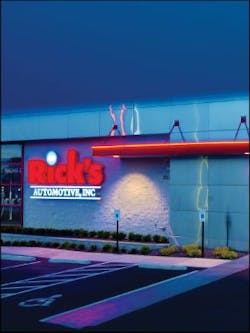Communication separates man from beast. This uniquely human skill predates every shred of recorded history and is a no-cost way to elevate your shop—as well as its reputation—far above your competition.
Jim Smith, a senior consultant at Management Success!, says communication is the great variable facilitating a “very well paid, very upbeat, professional staff that you get a lot of compliments about and a shop that’s very profitable that has a great reputation.”
“Here’s a basic principle that I’ve seen to be true—it came from Mike Lee, one of the founders of Management Success!—and that is that a well-run shop will expand, a well-run shop will survive,” he says.
Tim Cummings, vice president of operations at Rick’s Automotive, a full-service shop in Springfield, Mo., has implemented a variety of customer communication tactics including little things technicians notice like oiling squeaky door hinges, as well as asking customers for their preferred method of communication every time they visit the 28-bay facility.
There is no shortage of strategies to improve the bottom line or improve various metrics in the auto repair industry, yet customer communication is more of a global issue that can bolster every aspect of your business. Here are seven simple steps to set a foundation of successful customer communication.
1. Hire happy people.
Smith says hiring good, happy people is the building block your entire customer service program rests upon. Anyone in charge of hiring shouldn’t just look for skilled workers, but also people with a good attitude, enthusiasm for adopting a customer-centric approach, and steady personal lives that put them in a position to consistently focus on the customers with their full attention.
“If you’ve got somebody in the front counter who has a lot of personal problems, is he going to be able to really give the customer the attention that they deserve? Probably not,” says Smith. “It’s not that we’re trying to hire people that are perfect, but we’re trying to hire people that have enough empathy, enough good attitude, enough positives going for them that it helps to spill over into the other people.”
2. Display genuine empathy.
Speaking of empathy, Smith adds that being able to understand and relate to customer concerns is a key component in a business where customers are frequently stressed about the cost of repairs or a potential lack of transportation while their car is in the shop.
“We want the service writer to be an expert in communication, and they’ve got to be comfortable even in front of an upset customer, so we help them develop skills to do that,” he says. “A good, strong acknowledgement goes a long way: ‘You’re right; yes, sir, we shouldn’t have done that; let me take care of that for you.’”
In his role at Rick’s Automotive, Cummings says a major focus is learning the names of as many customers as possible, with the goal of greeting customers by their first name as soon as they walk in the door. Even more, each of the company’s 38 staff members are trained to greet customers, including technicians, should the opportunity arise.
“Every other week on Tuesday, we have a lunch meeting here at the shop, and that gives us the opportunity to … go over the training that’s coming up and we also go over some of the customer service,” Cummings says. “I try to teach our mechanics [that] if they come up front, you greet all customers, because they see a Rick’s Automotive shirt on you. They don’t know if you’re a service advisor or a parts manager or a technician.”
3. Educate the Customer.
Because shops inherently know more about vehicles than customers, Smith advocates focusing on educating customers on the many benefits of preventative maintenance so they understand that your mission is looking out for their safety and protecting their investment, rather than up-selling.
Put simply, preventative maintenance education means instructing employees to take time to explain the details of what’s affecting the customer’s car, and using visceral cues, like images of damaged components, to help make the case.
“When it’s done honestly and sincerely, your service writers demonstrating care for the customer, that’s what the shop owner’s looking for, because that’s also what the customer’s looking for,” he says. “The shop owner wants somebody that’s going to take care of his customers the way that the owner would. Sometimes you’ve got to go through a few people before you find people that will do that for you.”
4. Ask for preferred method of contact.
Whenever customers walk into Rick’s Automotive—whether they’re first timers or regulars—they are asked to fill out a form that asks for their preferred method of contact during the day. Rather than just asking customers this information on their first visit, Cummings says this practice recognizes that people are busy and every day is not the same.
The same form also asks customers how they heard about Rick’s Automotive, as well as what radio stations or TV stations they watch, which aids in allocating future marketing dollars.
Methods of customer communication include text messaging, email, phone calls, automated follow-ups, and handwritten thank-you notes that add authenticity—something Cummings feels is frequently lacking from larger companies.
“Every time they come in, we need to ask them, ‘What is the best way to communicate with you today?’” he says. “Tomorrow they might be on the road with their job and want to communicate by cell phone, [but] today they’re in meetings and want text messages. So we actually have a form that they fill out at the counter.”
5. Keep your customers in the know.
The easiest way to fail at customer communication, Cummings says, is to go dark when your customers are awaiting an update on their vehicle. Rick’s Automotive customers are told when to expect an update, ideally before lunchtime and, for sure, by the middle of the afternoon.
“I think it’s very important to give them a call because there’s nothing worse than that customer sitting at home waiting, or maybe they’re at work and wondering what’s going on with the vehicle,” he says. “The longer it goes into the day, the more anxiety they feel because it’s the not knowing that bothers them.”
6. Shut your mouth!
An appropriate time to keep quiet, Smith says, is when customers are explaining what’s wrong with their car. Beyond the basics needed for diagnosing, customer-facing employees should be looking for nonverbal cues that could show their true concerns—like wondering how they’ll get to work the next morning. He added that employees also should avoid using jargon that will be confusing or off-putting to some clients.
“You have two ears and one mouth, you should be listening more than you’re talking,” he says. “Listen to the customer, because the customer is not only telling you what they need and want, but they’re also giving you other indicators that are going to help you help them get the service that they need that’s going to keep their car safe and reliable.”
7. Go the extra mile.
Passed down from Rick’s Automotive founder, Rick Hughlett, the entire staff now works to take care of minor items like the aforementioned squeaky door hinges, burned out marker lights, topping off fluids and even vacuuming out cars before they are returned.
“You always want to leave the customer with what we call the ‘Wow Effect,’” Cummings says. “I want to catch the things that are annoying to the wife, but she forgot to tell you, and be attuned to what little … nugget can I do to each car to give them a wow.”



